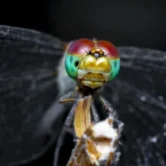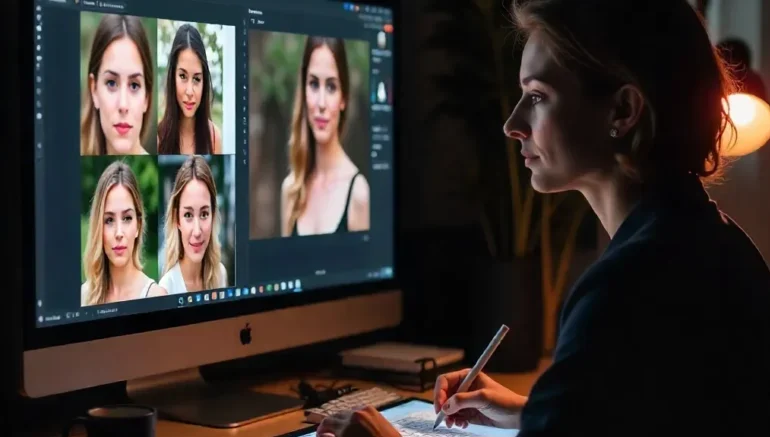
Achieve Realistic Photo with AI and Manual Retouching
Achieve realistic photo is something every photographer aims for, but it can be tricky. With so many editing tools available, it’s easy to overdo adjustments and make images look artificial. That’s where combining AI and manual retouching helps. AI tools can quickly handle tasks like color correction, background cleanup, or exposure fixes, saving a lot of time. Manual retouching allows for precise adjustments that preserve subtle details and the natural feel of a photo. Using both methods together makes your images look polished and professional without losing authenticity.
Finding the right balance between AI and manual work is key to creating photos that feel real and inviting. While AI handles repetitive or simple edits fast, manual retouching make sure that skin tones, shadows, and textures look just right. Even small adjustments, like smoothing highlights or fine-tuning colors, can make a big difference in maintaining a natural appearance. Photographers of all levels can benefit from combining these approaches to save time and improve quality. In this guide, we’ll explore how to use AI and manual editing together so your photos look their best while keeping that natural touch.
Role of AI and Manual Retouching in Achieving Realistic Photo
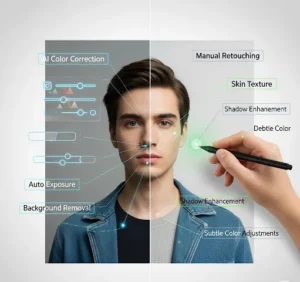 AI and manual retouching each bring unique strengths to photo editing. AI tools are designed to handle repetitive tasks quickly, like adjusting exposure, correcting colors, or removing simple background distractions. This speed makes it easier to manage large batches of images without spending hours on each photo. On the other hand, manual retouching allows a human editor to focus on fine details, such as skin texture, lighting balance, and subtle color adjustments.
AI and manual retouching each bring unique strengths to photo editing. AI tools are designed to handle repetitive tasks quickly, like adjusting exposure, correcting colors, or removing simple background distractions. This speed makes it easier to manage large batches of images without spending hours on each photo. On the other hand, manual retouching allows a human editor to focus on fine details, such as skin texture, lighting balance, and subtle color adjustments.
Combining both methods can give you the efficiency of AI while keeping the personal touch that makes photos look natural and professional. Knowing when and how to use each method is important if you want to achieve realistic photo results. AI works best for tasks that need speed and consistency, while manual editing is stronger for precision and creativity. By combining their strengths, you can achieve realistic photo outcomes that save time, improve quality, and keep your work looking polished.. Here are a few tips to make the most of both:
- Use AI to handle basic corrections and repetitive tasks.
- Rely on manual retouching for delicate details and natural finishes.
- Always review AI-edited photos to make sure that they don’t look over-processed.
- Combine both approaches when you need fast results without sacrificing quality.
How AI Can Help Save Time Without Losing Quality
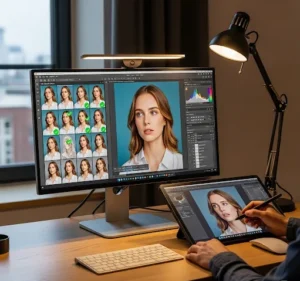 AI photo editing tools are designed to make common editing tasks faster and more efficient. They can automatically correct colors, adjust brightness, remove backgrounds, and even smooth minor imperfections in seconds. This is especially helpful when you are working with large batches of images, like product photos, real estate shots, or social media content. Using AI for these tasks allows you to focus your time and energy on the images that need more careful attention. It’s a great way to maintain consistent quality across many photos without spending hours on each one.
AI photo editing tools are designed to make common editing tasks faster and more efficient. They can automatically correct colors, adjust brightness, remove backgrounds, and even smooth minor imperfections in seconds. This is especially helpful when you are working with large batches of images, like product photos, real estate shots, or social media content. Using AI for these tasks allows you to focus your time and energy on the images that need more careful attention. It’s a great way to maintain consistent quality across many photos without spending hours on each one.
While AI can speed up editing, it’s important to use it thoughtfully to avoid over-processing. Even though AI works fast, it may not always perfectly replicate natural colors, lighting, or textures. Reviewing and fine-tuning AI edits to make sure that your photos still look realistic and professional. Here are a few tips to get the best results with AI:
- Use AI for repetitive tasks like resizing, cropping, or color adjustments.
- Apply AI to large batches first, then review the results before finalizing.
- Combine AI with manual retouching for images that require extra detail.
- Keep the original files so you can compare before and after edits.
Why Manual Retouching Matters to Achieve Realistic Photo
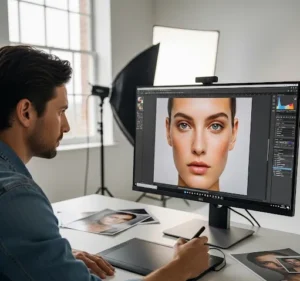 Manual retouching is important for achieving photos that feel authentic and polished. Unlike AI, which follows preset algorithms, manual editing allows a human editor to make careful adjustments based on what looks natural to the eye. This includes fine-tuning skin tones, balancing shadows and highlights, and improving textures without overdoing them. Manual retouching also helps preserve the mood and personality of a photo, making it feel more realistic and engaging.
Manual retouching is important for achieving photos that feel authentic and polished. Unlike AI, which follows preset algorithms, manual editing allows a human editor to make careful adjustments based on what looks natural to the eye. This includes fine-tuning skin tones, balancing shadows and highlights, and improving textures without overdoing them. Manual retouching also helps preserve the mood and personality of a photo, making it feel more realistic and engaging.
For portraits, fashion, or product photography, this level of attention can make the difference between an average image and a professional-looking one. Even though manual editing takes more time than AI, it provides control and precision that machines can’t match. Small changes, like smoothing a shadow or adjusting a highlight, can dramatically improve the final result. Combining these careful adjustments with AI shortcuts can save time while keeping the photo natural. Here are a few tips for effective manual retouching:
- Focus on subtle changes that highlight, not over-process, the photo.
- Pay attention to skin textures, hair, and fabric details.
- Compare the edited version with the original to maintain realism.
- Use manual retouching for key images that need high-quality results, like portfolios or client work.
Combining AI and Manual Techniques to Achieve Realistic Photo
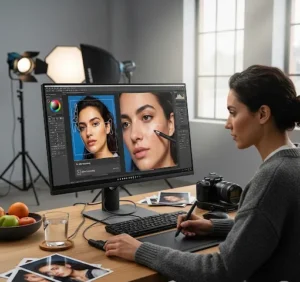 Using AI and manual editing together can give you the best of both worlds. AI tools are excellent for speeding up repetitive tasks like color correction, exposure adjustments, and background removal. Meanwhile, manual retouching allows you to refine details, refine textures, and maintain a natural look that AI alone might miss. By combining both methods, you can save time on large batches of photos while still achieving professional-quality results. This approach works well for photographers handling anything from e-commerce images to portraits, where both speed and accuracy matter.
Using AI and manual editing together can give you the best of both worlds. AI tools are excellent for speeding up repetitive tasks like color correction, exposure adjustments, and background removal. Meanwhile, manual retouching allows you to refine details, refine textures, and maintain a natural look that AI alone might miss. By combining both methods, you can save time on large batches of photos while still achieving professional-quality results. This approach works well for photographers handling anything from e-commerce images to portraits, where both speed and accuracy matter.
Finding the right balance between AI and manual techniques helps you achieve realistic photo results without wasting time. Start with AI to manage quick edits, then use manual retouching to refine details and make the image look more natural. By combining both methods, you can achieve realistic photo outcomes that are polished, clear, and professional—without the risk of over-editing. Here are some tips to make the combination work effectively:
- Use AI for bulk corrections and simple adjustments.
- Apply manual retouching for details like skin, lighting, and texture.
- Check AI-edited images before finalizing to make sure that they look realistic.
- Create a workflow that blends AI and manual edits for consistent, high-quality results
Tips to Achieve Realistic Photo That Look Polished
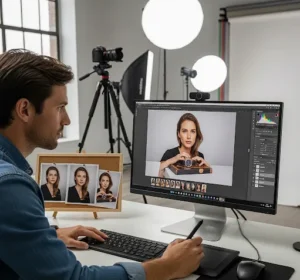 Keeping your photos looking real and polished requires careful attention to detail. Small adjustments in brightness, contrast, and color balance can make your images look clean without losing their natural feel. Over-editing, like heavy filters or extreme smoothing, can make photos appear artificial, so it’s better to upgrade subtly. Paying attention to small distractions in the background or minor blemishes can improve your image without changing its core look. A polished photo should feel natural while still drawing attention to the main subject.
Keeping your photos looking real and polished requires careful attention to detail. Small adjustments in brightness, contrast, and color balance can make your images look clean without losing their natural feel. Over-editing, like heavy filters or extreme smoothing, can make photos appear artificial, so it’s better to upgrade subtly. Paying attention to small distractions in the background or minor blemishes can improve your image without changing its core look. A polished photo should feel natural while still drawing attention to the main subject.
Another key to maintaining realism is consistency. Check your photos across different devices to make colors and lighting appear correct everywhere. Use editing tools to refine details, but avoid extreme changes that alter the original scene. Practicing restraint and reviewing your edits can help you find the right balance between improvement and authenticity. Over time, these habits make your photos look professional while keeping them believable.
Tips for keeping photos real and polished:
- Adjust brightness, contrast, and color subtly.
- Avoid heavy filters or over-smoothing.
- Remove small distractions or blemishes without overdoing it.
- Maintain shadows and highlights for natural depth.
- Review images on multiple devices for consistent color and lighting
Common Mistakes to Avoid When Editing Photos
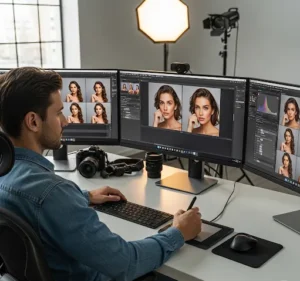 Photo editing can greatly improve your images, but common mistakes can make even a good shot look unnatural. One frequent error is over-editing, such as applying too much color saturation, overly smoothing skin, or adding heavy filters. Another mistake is ignoring composition issues; cropping or straightening photos after editing is just as important as adjusting colors. Failing to check lighting and shadows can also make an image appear flat or unrealistic. Being aware of these errors helps you maintain the natural look of your photos.
Photo editing can greatly improve your images, but common mistakes can make even a good shot look unnatural. One frequent error is over-editing, such as applying too much color saturation, overly smoothing skin, or adding heavy filters. Another mistake is ignoring composition issues; cropping or straightening photos after editing is just as important as adjusting colors. Failing to check lighting and shadows can also make an image appear flat or unrealistic. Being aware of these errors helps you maintain the natural look of your photos.
Another mistake is inconsistent editing, especially when working with multiple images in a series. Using different styles, brightness levels, or color tones on photos meant to go together can make them clash visually. Over-reliance on automatic tools without manual adjustments can also produce poor results. Finally, skipping the final review on multiple devices may lead to unexpected issues with color or clarity. Taking the time to carefully edit and review photos to make sure they look polished and professional.
Tips to avoid common editing mistakes:
- Don’t overuse filters, saturation, or smoothing tools.
- Check composition and crop or straighten as needed.
- Keep lighting and shadows natural.
- Maintain consistency across multiple images.
- Review your edits on different screens to assure accuracy.
Key Manual Adjustments That Make Photos Look Real
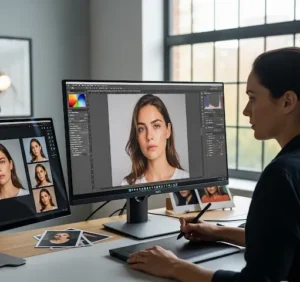 Manual adjustments are important for giving your photos a natural and realistic look. While AI can handle many tasks quickly, it may miss subtle details that make an image feel authentic. Manual editing allows you to refine elements like skin tones, shadows, and highlights, making sure that the photo maintains its original mood and depth. Paying attention to texture, lighting balance, and color accuracy can transform a good photo into a professional-looking image. These small adjustments often make the biggest difference in preserving realism while improving overall quality.
Manual adjustments are important for giving your photos a natural and realistic look. While AI can handle many tasks quickly, it may miss subtle details that make an image feel authentic. Manual editing allows you to refine elements like skin tones, shadows, and highlights, making sure that the photo maintains its original mood and depth. Paying attention to texture, lighting balance, and color accuracy can transform a good photo into a professional-looking image. These small adjustments often make the biggest difference in preserving realism while improving overall quality.
Some key manual adjustments to focus on include correcting exposure, fine-tuning colors, and smoothing highlights or shadows without overdoing it. Adjusting contrast carefully can add depth without making the image look harsh. Removing minor distractions, like stray objects or blemishes, helps keep the subject as the main focus. By combining these precise edits with a light touch, photographers can create polished images that look true to life.
Tips for key manual adjustments:
- Fine-tune exposure and brightness for balanced lighting.
- Adjust colors subtly to maintain natural tones.
- Smooth highlights and shadows without flattening textures.
- Remove small distractions to keep the focus on the subject.
- Compare edits with the original photo to assure realism.
Conclusion
Editing photos to look natural and polished takes practice, patience, and the right balance between AI tools and manual retouching. While AI can save time on repetitive tasks, manual editing to make sure that the simple details stay real and professional. The more you pay attention to lighting, colors, and textures, the better your final images will look. Remember, small adjustments often make the biggest difference, and consistency across your photos is key. What editing habits or tools do you use to keep your photos looking natural? Share your tips or experiences in the comments below. We’d love to hear how you balance AI and manual editing in your workflow.
Read Next: Top 10 Real-Life Examples of AI vs. Manual Photo Editing Results





